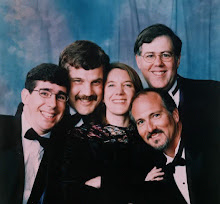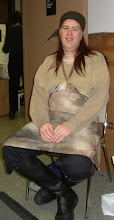I wanted to share some thoughts
about the controversy that has erupted in Seattle over the Seattle Gilbert
& Sullivan Society’s 60th anniversary production of “The
Mikado.” They had barely opened the show
when a Seattle Times reporter – Sharon Pian Chan – penned an editorial entitled
“Yellow-Face in Your Face.” In this
article she essentially ripped apart the company, accused them of being racist,
accused them of racist casting and condemned the work itself as racist. And once her article hit many internet
trollers came out of the woodwork to join in the attacks and condemnation –
much of it in harsh and hateful ways.
For its part the company seems to be in shock. They have not responded well – IMHO.
I have not seen the production –
and neither had Ms. Chan before she felt qualified on the basis of her own
presumptions to trash the piece and production – so I cannot and will not speak
to this specific production. But I can
speak about the piece that I know very, very well. This then brings up a very important point.
There is a difference between the piece and the production. A much more thoughtful review of the piece by
a journalist who actually took the time to see the show pointed this out
(Walter Ryce): (Read the piece here) He stated that there were some elements of the production
that were over the line and advised dialing them back. Of course that is right. The piece itself is set in a stylized and
fantasy Japan that never has really existed, but to over-Japan it with
stereotypes – in make-up, costuming, bowing and high pitch nasal voices or even
(God forbid) with a fake Japanese accent IS racist. I don’t know which of these Seattle is guilty
of, but this criticism is well-taken and should be carefully considered. I have seen productions where eye make-up and
lots of bowing and Ninja poses were a part of the show. The time for this kind of thing is gone. Directors and performers need to approach
this work with more sensitivity to these kinds of things.
This reviewer also suggested that
it was possible to completely remove all of the faux Japanese setting from the
work. I am a little more skeptical of
this. The productions he cited in the
review drew groans from my friends on Savoynet as the general consensus was
those particular productions were really badly done and consequently not really
good examples. There is an example
however of a very well done production which has managed to successfully move
away from the “traditional” Japanese stereotypes. This is the English National Opera production
from the 1990’s starring Monty Python’s Eric Idle as Ko-Ko. It is worth a look.
I have to say at this point
however, that for me one of the most troubling parts of this whole controversy
is the fact that Ms. Chan did not bother to see the show, to read the show, to
listen to the music or do any research about the history of the show before she
felt compelled to write about it. She
saw a photo – one from a previous production years ago – and drew her
conclusions based on this. How in the world
is this appropriate? How can she claim
to be a professional journalist when she shoots from the hip based on her own preconceptions
and does no background work. At the very
least she should have gone to see the show, and she can still do this and I hope
she does.
But this seems to be a trend in our
current times. The days when journalists and others actually researched their
subjects before issuing judgments seems to have passed. A similar thing happened recently at the
Metropolitan Opera in New York City.
Peter Gelb, the General Director of the Met, announced that the HD
broadcast of John Adam’s “The Death of Klinghoffer” would be cancelled because
the Anti-Defamation League and others (probably wealthy donors) felt the piece
was anti-semitic. This is a serious
charge. What proof did they offer? Well, none.
None of them had bothered to actually watch the opera (it is available
on DVD and there are clips on Youtube) or to read the libretto (which is also
available). The ADL executive director actually
admitted that he had not seen the show before drawing his conclusions. I am sorry, but as far as I am concerned Ms.
Chan and the anti-Klinghoffer crowd have no credibility if they cannot find a
little time to actually experience a work before condemning it. I find it an incredible disappointment that
Mr. Gelb caved to this. If it had been
me, I would have invited the critics to meet me in my office and we would have
screened the work with the librettist and composer present and engaged in a
discussion. Had Mr. Gelb done that and
then decided to cancel I could have been more supportive of the decision. The same situation is repeated here in
Seattle – shoot from the hip about something you know nothing about. Ms. Chan – you have no credibility. Go see the show and then write about it.
(A couple articles about the Met decision worth reading:
But is the “Mikado” itself racist? CK Chesterton once pointed out that "not
one barb or criticism in the Mikado is aimed at the Japanese. All its satire
fits the English." I believe that the work itself is not racist as
it stands. The piece was written and
composed in the late 19th century.
That is a different world from ours.
Gilbert created a stylized setting in which he could satirize and make
fun of late 19th century British culture and politics. The chorus tells us as much in the opening
chorus – “on vase, on jar, on screen, on fan.”
The names of the characters themselves are not Japanese. They are derived from English slang. Gilbert had no intention of mocking Japanese
culture. In fact, he went out of his way
to try to respectfully include Japanese elements in the first production. But at the same time, Gilbert was a man of
his time and at the height of the British Empire he like many of his
contemporaries had a strong and even arrogant sense of cultural superiority. He was British nationalist to be sure. His fascination with Japan was as a
well-establish English man of means. His
respect of things Japanese would have probably also included a strong element
of being patronizing. It is fair to
review the work with this in mind when preparing a production. It is also instructive to note that in the
early 20th century after Gilbert, Sullivan and Richard D’Oyly Carte
had died and Bridget D’Oyly Carte was running the company the British
government banned productions of the “Mikado” for a time out of fears of
embarrassing and insulting a Japanese diplomatic delegation. Bridget took it upon herself to invite a
Japanese journalist to a private performance.
His response was that he loved the show, he laughed throughout and
stated that the piece was not about Japan, it was about England. And that is the point.
I also think we need to be very
careful about superimposing 21st century sensibilities and
categories upon previous times. Our 21st
century understanding of racism has come about through a painful history of 20th
century events. Racism in America is a
serious and pervasive problem. To accuse
Gilbert or Dickens or Shakespeare of racism is simply unfair and
uninformed. They were men of their times
and we cannot retroactively apply our own understandings upon them. However, it would be irresponsible for us not
to be sensitive to present day concerns about racism. The “yellow-face” staging traditions are
offensive to many, and not necessary to the piece; Gilbert used the “N” word in
two places in Mikado, this has been rightly changed. Despite what Gilbert’s understanding of that
word was then, it is completely inappropriate now.
Ms. Chan complains about the
casting. Surely there are Asian actors
who could play these parts. Well (sigh)
these comments show a complete lack of understanding of the process of
casting. First, the piece (as stated
above) is actually about England and British institutions. The characters are all British. 2nd, it is not enough to find a
good actor, one needs an actor who can sing and dance in a 19th century
operetta. Undoubtedly there are many who
qualify and I know that Seattle like most groups have an open audition system
and any and all who are interested are welcome to apply. Should Asian actors be given preference –
cast as Nanki-Poo or Yum-Yum when they are clearly not qualified or capable or
doing the roles, or not the best candidates?
If so, how would that be better?
In fact the Seattle company is multi-racial – a fact she would have
noted had she attended a performance.
Should only Asian artists perform
Asian roles? Should only black artists
perform black roles? George Gershwin
specified in his will that “Porgy and Bess” was only to be performed by black
singers. What about “South
Pacific?” The recent Broadway production
did use Asian performers for Bloody Mary and Liat. But should a community group not do the piece
if there are no Asian performers available or interested? I don’t think so. Some have brought up the operas “Turandot,”
or “Butterfly?” And we could create a
long, long list. It would be a poorer
world if performances of these great works were curtailed because it was not
possible to fill the roles with qualified ethnic singers. And this in not an easy proposition: take the
opera “Otello” for example. The vocal
demands for the lead role are extreme.
There are few tenors who can sing this role. Perhaps the greatest Otello of the 20th
century was the great Spanish tenor Placido Domingo. He was always made up so that his skin looked
darker. Is this racist? I do not think so. The piece is a piece that needs to be
performed and the number of tenors in general (not to mention black tenors in
particular) who can sing the role are few and far between.
Finally, I have to wonder why Ms.
Chan felt this little 19th century operetta required so much time
and scrutiny. We have currently in this
world a war in Iraq, a war in Gaza, a war in Ukraine and a war in
Afganistan. Currently there is an influx
of children flooding our borders from Central America that has been met with a
decidedly racist response by people in Texas.
We have a terrible problem with gun violence, no reasonable restrictions
on guns, a prison structure that is very racist and yet Ms. Chan is writing
about a 19th century operetta she doesn’t even know. It makes no sense to me. Racism is prevalent and real – just watch the
news and the see the images of the people screaming at the children in the
buses; look at the attacks on President Obama – we need to address this issue
seriously. For me the saddest part of this
entire affair is that Ms. Chan could have used her position to prompt an
intelligent discussion and dialog. But
instead she chose to simply write an uninformed angry piece of condemnation
about which she knows little to nothing.
The people of Seattle and of our nation deserve better.


